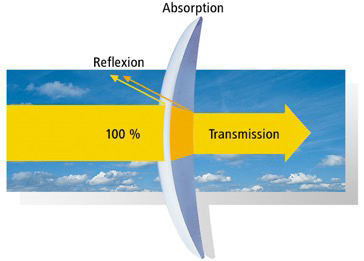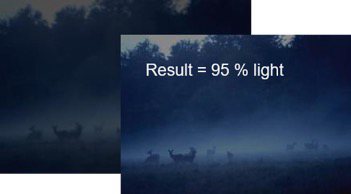Understanding the mechanics behind low-light performance in an optic is critical to the hunter. The “golden hour” of opportunity at first and last light is prime for hunting success. It is a terrible time to discover you don’t have the ability to safely and ethically take a shot because your optic doesn’t possess good low-light performance.
Most people purchase an optic from well-lit sporting goods stores or an online venue, and because of this, judging the low-light performance of any optic can be a challenge. On rare occasions, you may be able to demo product from a retailer, but this is not the case most of the time. You can only experience low-light optical performance during low light conditions. So, how can you be sure you’re buying a scope with great performance in subdued light? You can begin to answer this question by understanding how a high-performance optic is built and functions in lower ambient light. If you’re searching for an optic that performs well in these conditions, consider these three points:

As light passes through each lens surface of the optic, a portion is reflexed – each time reducing the amount of light transferred to the eye. Lens coatings work to minimize reflexion (reflection) of light in the blue light spectrum and maximize reflections of light in the red, orange, yellow, and green spectrum. The rods in the eye are more sensitive to visible light in the in blue spectrum, therefore, the bluer light transmitted will result in higher contrast and a better resolved low-light image.
|
1. The manufacturer’s measured light transmission (if the data provided is to-the-eye value) is a good indicator of performance. A value of 90-percent or more is optimal. However, some optics manufacturers often advertise light transmission (LT) numbers which can be misleading. How so? The technology which currently exists will not deliver much beyond 96-percent LT to the eye, meaning through the entire optical instrument to the user’s eye. So, how can a manufacturer claim a higher LT? Read the fine print. There is usually a disclaimer containing language such as, “As measured surface to air.” The implication in simple terms means the LT stated is measured through a single lens surface and not the entire optic. Also consider this, I made mention in our last article, that in the world of optics, everything is a tradeoff. This is true with light transmission as well. Typically, when you approach the highest numbers in LT, say above 94.5 percent, there is generally a sacrifice in image quality or some imaging errors, such as chromatic aberration, which can occur in the right conditions. Reach out to the manufacturer of the optic you’re considering and ask them what the collective LT figure is for the instrument and look for a light transmission value of 92 percent to achieve a good balance of LT and image quality.

Combining quality optical glass, such as HT (high transmission) manufactured by Schott Glass, AG, with lens coatings, it is possible to achieve up to 96 percent light transmission to the eye. This photo is a real-world example of light transmitted at 95 percent versus light being transmitted through lower quality glass and coatings.
|
2. Research the lens coating technology for the brand of optic you are considering. It’s the coatings’ job to deliver as much of the right light as the shooting situation will allow, as well as doing so with as few imaging errors as possible. Transmitting all the light available, is not necessarily a good thing. You may remember the acronym ROY G BIV from your high school physics class, which helps us to remember the colors of the visible light spectrum. Those colors are red, orange, yellow, green, blue, indigo, and violet. During times of subdued lighting, when your pupil is dilating, the available light can then be fully received by the rods in your eye. The rods are more sensitive to light transmitted in the blue light spectrum. It is this light that which provides a high contrast sight picture during the prime hunting (low light) hours of early morning and late evening. Other colors of visible light within the spectrum work to hinder the quality of the image. Lens coatings enable the visible blue light to pass through the lens easily, but reflex, as much as possible, the other colors. Blue light, when transmitted through quality glass, such as Schott HT (high transmission glass), the choice of many premium optics companies, will also help to ensure the contrast is the highest resolution possible with the most LT which can be achieved.

When the exit pupil and the eye pupil are close to the same diameter, such as during the early mornings or evenings, then all the light transferred to the eye may be used to benefit the image quality. If the eye pupil is smaller than the exit pupil of the optic, as in bright daylight, then there is no additional image brightness gained. The eye pupil will work as a restrictor to the available light being transferred.
|
3. The optic should also have two important features. First, the exit pupil of the ocular should be large enough to provide proper image quality for the user. To see the exit pupil, hold the scope in one hand alongside your waist or thigh. Then, simply look down at the ocular lens’ surface. Centered in the middle of the lens, you will find the exit pupil, which on average will be a 4 to 6 millimeter image circle. The diameter of the exit pupil is paramount in perceived light transmission and comfort of viewing. The bigger the better. A smaller exit pupil will restrict the ease of viewing the target and the perceived light transmission to the eye when you need it the most – when the ambient light is waning and the pupil of your eye is enlarging. The exit pupil should be as closely sized as possible to the pupil of the human eye when dilated. Then, there will be no restriction in LT to the eye. Check its size at low and full power magnification. All manufacturers publish the exit pupil data for their products. Be sure to research this for the optic you are considering.
Secondly, a larger objective lens is helpful. The bigger the lens, the easier it is for light to enter the scope. Think of the drapery in your living room. If you pull the drapes close together, then the living room becomes darker. If you open them wide, the room fills with light. An objective size of at least 50 millimeters is recommended for better low-light performance. If you hunt in areas with subdued light much of the time, such as dense pine thickets or under heavy canopies, a better choice would be a 56-60-millimeter objective lens. It will make quite a noticeable difference in your sight picture.
If I were asked to pick the most important feature a rifle scope should possess for hunting, my choice would not be dialable turrets, nor would it be the type of reticle. I would tell you to buy a scope with great glass and exemplary low-light performance, because I have learned my best opportunities to harvest trophy animals usually come during the hours when the game will have the advantage and you will be at a disadvantage. The glass helps level the playing field. Go to your favorite dealer and look for an optic with these characteristics. Get behind the glass and see the difference it will make.
Good hunting, friends.
Editor’s Note: Want to know more about how and why animals move in low light? Here’s a link to a video about animal movement and low-light hunting from our partners at International Hunter Education Association (IHEA)-USA